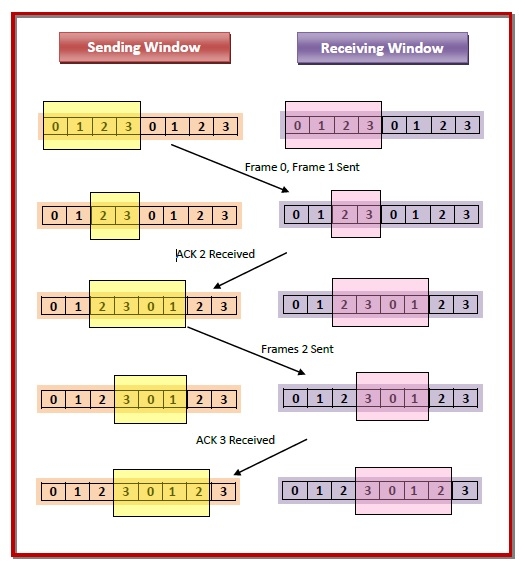
 Data Structure
Data Structure Networking
Networking RDBMS
RDBMS Operating System
Operating System Java
Java MS Excel
MS Excel iOS
iOS HTML
HTML CSS
CSS Android
Android Python
Python C Programming
C Programming C++
C++ C#
C# MongoDB
MongoDB MySQL
MySQL Javascript
Javascript PHP
PHP
- Selected Reading
- UPSC IAS Exams Notes
- Developer's Best Practices
- Questions and Answers
- Effective Resume Writing
- HR Interview Questions
- Computer Glossary
- Who is Who
Sliding Window Protocol
Sliding window protocols are data link layer protocols for reliable and sequential delivery of data frames. The sliding window is also used in Transmission Control Protocol.
In this protocol, multiple frames can be sent by a sender at a time before receiving an acknowledgment from the receiver. The term sliding window refers to the imaginary boxes to hold frames. Sliding window method is also known as windowing.
Working Principle
In these protocols, the sender has a buffer called the sending window and the receiver has buffer called the receiving window.
The size of the sending window determines the sequence number of the outbound frames. If the sequence number of the frames is an n-bit field, then the range of sequence numbers that can be assigned is 0 to 2?−1. Consequently, the size of the sending window is 2?−1. Thus in order to accommodate a sending window size of 2?−1, a n-bit sequence number is chosen.
The sequence numbers are numbered as modulo-n. For example, if the sending window size is 4, then the sequence numbers will be 0, 1, 2, 3, 0, 1, 2, 3, 0, 1, and so on. The number of bits in the sequence number is 2 to generate the binary sequence 00, 01, 10, 11.
The size of the receiving window is the maximum number of frames that the receiver can accept at a time. It determines the maximum number of frames that the sender can send before receiving acknowledgment.
Example
Suppose that we have sender window and receiver window each of size 4. So the sequence numbering of both the windows will be 0,1,2,3,0,1,2 and so on. The following diagram shows the positions of the windows after sending the frames and receiving acknowledgments.

Types of Sliding Window Protocols
The Sliding Window ARQ (Automatic Repeat reQuest) protocols are of two categories −

-
Go – Back – N ARQ
Go – Back – N ARQ provides for sending multiple frames before receiving the acknowledgment for the first frame. It uses the concept of sliding window, and so is also called sliding window protocol. The frames are sequentially numbered and a finite number of frames are sent. If the acknowledgment of a frame is not received within the time period, all frames starting from that frame are retransmitted.
-
Selective Repeat ARQ
This protocol also provides for sending multiple frames before receiving the acknowledgment for the first frame. However, here only the erroneous or lost frames are retransmitted, while the good frames are received and buffered.

